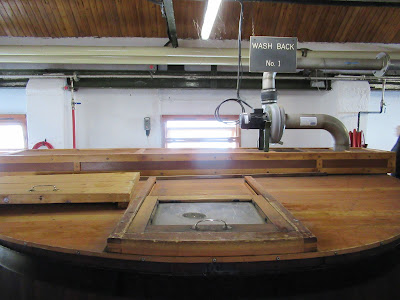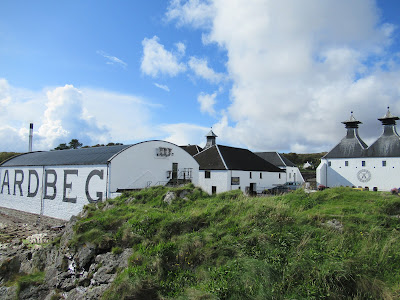Three cask strength, sherry cask, independent bottlings of Caol Ila. And while two are from refill casks they could easily pass for first-fill based on smell & taste. This'll be fun!
It's actually difficult to find anything that resembles a "bad" Caol Ila. As with every distillery and every brand there are some examples that are better than others, some very much so. But the starting point with this Islay giant is very solid, and it doesn't often dip below that bar unless something has gone wrong at some point - which is a rare occurrence. That's largely because of the distillery's primary function, which is to provide peated - and occasionally also unpeated - malt whisky for owner Diageo's blended whiskies - e.g. Johnnie Walker. That means taking a methodical & conservative approach in production in search of consistency, which will then make the blender's job easier down the line. But consistency in malt whisky is not an easy target to reach, particularly once one of the largest variables in the equation rolls into the picture: the cask. Natural variation is a huge part of what makes whisky fun, and it's a stubborn, almost alchemistic part of the process which is really rather fascinating. Try as a large corporate-owned distillery might, no two casks are ever identical, even those filled on the same day from the same spirit run, and even those matured in the same warehouse. In most cases, the larger companies and distilleries will compensate for these variations in their core range and their parent company's products by way of blending, which is an art form in itself. It's in the limited and/or single cask bottlings that the variances are allowed to shine, and even in the continuing whisky boom that sort of thing is often left to the independent bottlers.
The three independent bottlings of Caol Ila that we're looking at here are single cask bottlings from different bottlers, all filled into Oloroso sherry butts (500-litre casks), albeit one first-fill and two refill, and all are fully matured in those casks rather than being cask finished or double matured. I should add though that the two refill casks likely hadn't been used for very long in their first filling, since both have certainly been very active on their second tour of duty. All three casks were distilled in broadly similar vintages and bottled at broadly similar ages, and at broadly similar natural cask strengths. All three bottlings have age statements and are proudly declared to be non-chill filtered and naturally coloured. Despite their similarities on paper the variances between these three Caol Ilas are huge, and they were just crying out for comparison! The three different independent bottlers in question are rather different also; Glasgow-based North Star being the trendy, more progressive youth, London-based Elixir Distillers (a.k.a Specialty Drinks) being the thriving middle child, and Pitlochry-based Signatory Vintage being the older, more conservative sort that tends to be a little more conventional in packaging & presentation, but not necessarily when it comes to the whisky itself. The Elixir Distillers bottling that we have here is a little different since it was bottled for New Zealand-based importer & retailer Whisky Galore in 2019, specifically for their bi-annual DramFest whisky show. Technically it was a secret / mystery bottling, but if you peeled off the little white sticker on the label that said "censored", you'd find Caol Ila named right there on the label - hence the quirky name, but perhaps also because it's very much a dirty little secret - I've tasted it previously, and let's just say that the sulphur-sensitive will find it a challenge! Let's kick this three-way off with the most recent bottling, the North Star.
Distilled September 2009, fully matured in a first-fill Oloroso sherry butt, bottled October 2020. From cask series (release batch) 011. Non-chill filtered, natural colour. 410 bottles.
Colour: Gold. By far the palest of the three, despite being the only first-fill cask. But that doesn't matter.
Nose: Nice. Loads of caramel fudge, touch of cold ashy peat smoke and oily smoked salmon with dill - let's make that salmon gravlax, then. Some banana toffee (banoffee) pie, freshly charred wood, smoked bacon rind (uncooked), touch of dried seaweed and salted butter. Sounds like a strange combination, I know, but it works!
Texture: Medium weight. Starts soft & sweet and builds quickly. Sweet & quite youthful. Touch of numbing heat.
Taste: Sweet entry with banoffee with caramel on top, some pear juice behind, then big ashy peat smoke, fatty bacon (burnt, this time) and oily cured fish again - no dill this time. Grassy and malty.
Finish: Medium length. Touch of milk chocolate, slightly floral & malty, grassy sweetness. Caramelised pear and lemon zest.
Score: 3.5 out of 5.
Notes: Well this is a surprise! Quite young & fresh, but still reasonably rich. Loads of caramel, but I'd never have picked it as a first-fill sherry cask, particularly of the Oloroso variety. Having already tasted the other two whiskies featured in this three-way, this is the least overtly "sherried", and also the most youthful. What little sherry influence there is has been very well integrated with the spirit and doesn't really stand out at all. That's not a complaint mind you, just an observation. This sort of integrated sherry influence thing is why refill sherry casks tend to work well - but this is a first fill cask! So it's not quite what I expected from the "spec sheet", but there's nothing wrong with a youthful Caol Ila when done right.
Signatory Vintage Caol Ila 9-year old Single Cask, 59.7%. Islay, Scotland.
Distilled September 2010, fully matured in a refill Oloroso sherry butt, bottled March 2020. Signatory Cask Strength Collection, cask #316658. Non-chill filtered, natural colour. 625 bottles.
Colour: Bronze.
Nose: Bacon bits, rich toffee fudge, dried fruit - currants, dates, bitter orange. Salty cheese & bacon balls (cheetos / corn snacks), lemon zest, more bacon bits, muddy/damp peat and some ginger powder.
Texture: Medium weight. Rich & powerful, sweet & salty. Touch of heat but well integrated.
Taste: Salty, with dried seaweed & bacon bits. Dark, sweet salted caramel, pork rind and a touch of soy sauce. Maybe a little miso paste as well. Dried fruit - currants & orange, ashy peat around the edges.
Finish: Long length. Peaty & salty. Soy sauce, cheese & bacon balls (cheetos / corn snacks) again. Touch of grassy smoke and dried seaweed, and salted caramel fudge to finish.
Score: 4 out of 5.
Notes: Far richer, more sherried, and more mature in feel as well. Plenty of character and a great mix of salty, umami & richly sweet flavours, and a good amount of sherry influence backing it up. Yes it's a refill cask, but as I said at the beginning it could pass for a first-fill quite easily. The previous occupant certainly wasn't allowed to stay for very long! This Signatory was quite expensive unfortunately, circa $280 AUD, but if you can get past that it's a great Caol Ila that belies its age.
DramFest's Dirty Little Secret (Elixir Distillers), Caol Ila 11-year old, 56.9%. Islay, Scotland.
Distilled 2008, fully matured in a refill Oloroso sherry butt, bottled 2019 for Christchurch NZ-based Whisky Galore's DramFest whisky show 2020. Cask #2. Non-chill filtered, natural colour. 204 bottles. Colour: Dark copper.
Nose: Definitely dirty - and by that I mean sulphured. Rubber, vegetable chips, i.e. fried & salted root vegetables - parsnip & pumpkin, I'd say. Some salt & vinegar corn chips in there too. Touch of red bean paste, liquorice and dark soy sauce. Rancio notes - cured meats & roasted nuts.
Texture: Medium weight, but thins out quickly thanks to the sulphur.. No heat at all.
Taste: Rich & dirty on impact, more rancio sherry notes and thankfully less sulphur - but that's because it's had plenty of breathing time, both prior to pouring and in the glass. Cured pork, beef stock, salted nuts and a little orange. Rubber, aged balsamic vinegar. Sweeter sherry notes saving the day then with raisins, caramelised peanuts, and a touch of marzipan around the edges.
Finish: Medium length, but again it fades quickly thanks to that dirty, sulphured sherry influence. Rancio cured meats & balsamic, burnt peanut oil, dried fruit, sweet orange and date syrup (caramel).
Score: 3 out of 5.
Notes: Definitely not one for the sulphur sensitive or sulphur averse. I'm not usually overly sensitive to it myself, but despite substantial breathing time this is right on my limit. Well actually it's over my limit on the nose & finish, but thankfully the palate saves the day - just. This whisky has improved substantially with a lot of breathing time, i.e. a few months after opening. Was this intentional sulphur, ala Longrow 14-year old Sherry? Well I loved that whisky, but this Caol Ila is really pushing the limits of my friendship, so I'd say no, the sulphur here was probably more of the accidental variety. That's not to say that it's a "faulty" or "bad" whisky though, it's just going to be very, very divisive.
Overall Notes: Well, like I said, three totally different styles of sherry cask Caol Ila, and all are basically unrecognisable compared to the distillery's official bottlings. The Signatory is by far the winner for my tastes, but I can see the appeal of the other two as well, despite them each being at opposite ends of the spectrum. From clean, light, young & more integrated flavours in the North Star to the dirty, funky, acidic "Dirty Little Secret". The Signatory sails right up the middle between the two, taking the best from both worlds, and coming across as the most mature of the three despite actually being the youngest and also boasting the highest ABV. Unfortunately it was substantially more expensive than the other two, nearly double the price in fact, but I'd have to concede that the value is there.
Cheers!













